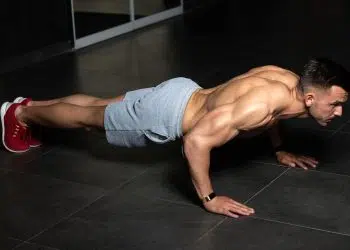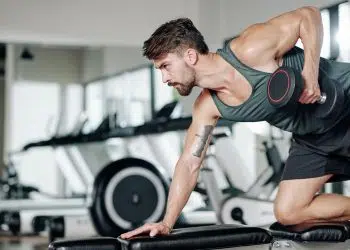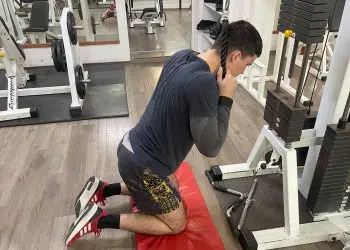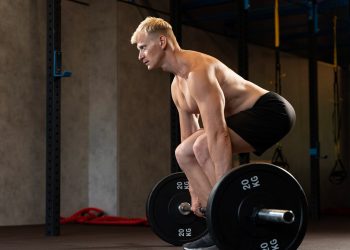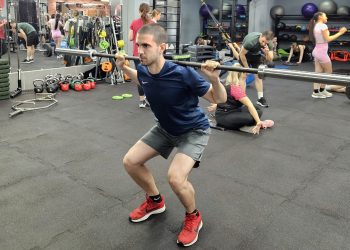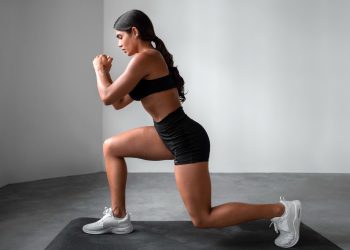The reverse plank is a great alternative to the standard plank. It mostly targets the glutes, hamstrings, and core, while also strengthening the back, arms, and shoulders. The reverse plank is a good strengthening exercise since you have to hold your body weight up while keeping your hips high and body straight.
Many people are unaware that the reverse plank is an effective alternative to the standard plank but it’s a great finisher exercise and hits essentially the same muscles. The great thing is you don’t need any equipment other than your own body weight to provide enough resistance for an effective workout.
In this Exercise
- Target Muscle Group: Gluteus Maximus, hamstrings, core
- Type: Strength
- Mechanics: Isolation
- Equipment: N/A
- Difficulty: Intermediate
Proper Form and Technique for the Reverse Plank
Step-by-Step Instructions
- Position: Start by sitting on the floor with your legs extended straight in front of you and your hands resting on the floor behind your hips, fingers pointing towards your feet.
- Engage: Press your palms firmly into the ground and engage your core muscles to stabilize your body.
- Lift: Inhale and lift your hips off the floor, driving through your heels and squeezing your glutes. Your body should form a straight line from your head to your heels.
- Hold: Keep your gaze towards the ceiling and maintain the position, breathing steadily. Aim to hold the reverse plank for 30 seconds or more, depending on your fitness level.
- Lower: Slowly lower your hips back to the floor and relax. Repeat the exercise for the desired number of sets.
How to do a high reverse plank
How to do a reverse plank
Variations & Tips
- You can do a reverse plank with your forearms supporting your body weight as an alternative (See the second video for instructions).
- Keep your body in a straight line and don’t sag your hips.
- You can point your fingers in any direction while performing this exercise.
- This exercise strengthens your posterior chain muscles (Glutes, hamstrings, and erector spinae) abs, triceps, and shoulders.
Progressions and Modifications
Beginner Modifications
If you’re new to the reverse plank, try these modifications to build strength and improve your form:
- Bent Knees: Instead of extending your legs straight, keep your knees bent and your feet flat on the floor. This reduces the intensity of the exercise and provides more stability.
- Hands Elevated: Place your hands on a stable, elevated surface like a step or bench to decrease the difficulty of the movement.
Advanced Progressions
Once you’ve mastered the basic reverse plank, challenge yourself with these advanced progressions:
- Leg Lifts: While in the reverse plank position, lift one leg off the ground, keeping it straight. Hold for a few seconds, then switch legs.
- Single-Arm Reverse Plank: Lift one arm off the ground and extend it straight in front of you, maintaining balance and stability.
Variations to Keep Your Workouts Engaging
Add variety to your workout routine with these reverse plank variations:
- Reverse Plank with Leg Cross: In the reverse plank position, cross one ankle over the other and perform a leg lift, maintaining the crossed position. Switch legs after completing the desired number of reps.
- Reverse Side Plank: Start in a side plank position, then lift your top leg and arm to form a reverse side plank. Hold the position for the desired duration, then switch sides.
Benefits of the Reverse Plank Exercise
Incorporating the reverse plank into your fitness routine offers numerous benefits, including:
Level Up Your Fitness: Join our 💪 strong community in Fitness Volt Newsletter. Get daily inspiration, expert-backed workouts, nutrition tips, the latest in strength sports, and the support you need to reach your goals. Subscribe for free!
- Posterior Chain Activation: The reverse plank engages the entire posterior chain, helping to strengthen your lower back, glutes, hamstrings, and shoulders.
- Improved Core Stability: This exercise challenges your core muscles, leading to better balance, stability, and functional strength.
- Enhanced Posture: By strengthening your posterior chain and core, the reverse plank can help improve your posture and alleviate discomfort caused by muscle imbalances.
Integrating the Reverse Plank into Your Workout Routine
The reverse plank can be incorporated into various workout routines, such as:
- Core Workouts: Include the reverse plank as part of your core-focused training sessions, alongside other exercises like the plank, side plank, and Russian twists.
- Circuit Training: Add the reverse plank to your circuit training routine to create a well-rounded workout that targets multiple muscle groups.
- Warm-up or Cool-down: Use the reverse plank as a dynamic warm-up or cool-down exercise to engage your posterior chain and core muscles before or after your main workout.
Muscles Worked in the Reverse Plank Exercise
The reverse plank is a compound exercise that targets multiple muscle groups throughout the body. Here’s a breakdown of the primary muscles worked during the reverse plank:
1. Gluteus Maximus
The gluteus maximus, the largest muscle in the buttocks, plays a significant role in lifting and maintaining the hips in the reverse plank position. It’s responsible for hip extension and helps stabilize the lower body.
2. Hamstrings
Located at the back of the thigh, the hamstrings contribute to hip extension and knee flexion. In the reverse plank, the hamstrings work together with the gluteus maximus to lift and hold the hips in position.
3. Erector Spinae
The erector spinae, a group of muscles running along the spine, support spinal extension and stability. During the reverse plank, the erector spinae muscles help maintain a straight body line and protect the spine from excessive flexion.
4. Core Muscles
The reverse plank engages various core muscles, including the rectus abdominis, transverse abdominis, and obliques. These muscles work together to stabilize the trunk and maintain proper alignment throughout the exercise.
5. Deltoids
The deltoids, or shoulder muscles, provide support and stability as you press your hands into the ground. The anterior (front) deltoids play a crucial role in maintaining the reverse plank position, while the medial (middle) and posterior (rear) deltoids contribute to overall shoulder stability.
6. Triceps
The triceps, located at the back of the upper arm, are responsible for elbow extension. In the reverse plank, the triceps work to keep your arms straight and provide stability throughout the exercise.
By targeting these muscle groups, the reverse plank exercise offers a comprehensive workout that improves overall strength, posture, and functional fitness.
Frequently Asked Questions
How often should I perform the reverse plank exercise?
For optimal results, incorporate the reverse plank into your workout routine 2-3 times per week. As with any exercise, it’s essential to give your muscles adequate time to recover and adapt between sessions.
How long should I hold the reverse plank position?
Beginners should aim to hold the reverse plank for 15-30 seconds, gradually increasing the duration as strength and endurance improve. Advanced exercisers can challenge themselves by holding the position for 60 seconds or longer.
Can the reverse plank help alleviate lower back pain?
The reverse plank can be beneficial for individuals experiencing lower back pain by strengthening the core and posterior chain muscles. However, it’s essential to consult with a healthcare professional or certified personal trainer before attempting the exercise to ensure proper form and prevent further injury.
Conclusion
The reverse plank is a versatile and effective exercise that strengthens the entire posterior chain, enhances core stability, and improves posture. By mastering the proper form and incorporating progressions, modifications, and variations, you can challenge yourself and reap the benefits of this powerful exercise. Don’t forget to include the reverse plank in your fitness routine to elevate your workouts and achieve your fitness goals.
Interested in measuring your progress? Check out our strength standards for Hip Extension, Russian Twist.


